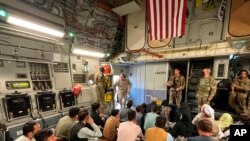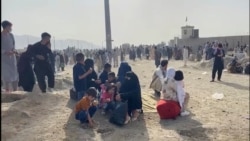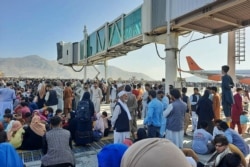For Jeffery A. Trammell, a former U.S. Army officer who served two tours in Afghanistan, the hours and days since the Taliban swept into Kabul have been an unending barrage of phone calls, emails, and text messages, all centered on one object -- trying to get his former Afghan interpreter safely out of the country.
The interpreter, whose first name is Najeeb, is one of thousands of Afghans who served with U.S. forces and later applied for a Special Immigrant Visa that would allow them to leave the country with their families. But despite letters of recommendation from Trammell and years of waiting, Najeeb’s visa was never approved.
For days after the Taliban entered Kabul, Najeeb, his wife and three daughters hid out in a home in Kabul that is within sight of Hamid Karzai International Airport, access to which has been limited by Taliban checkpoints. He occasionally snapped pictures of giant C-17 military transport planes as they took off from the runway and texted them to Trammell, along with pleas for information.
‘The Taliban are now going home to home’
“He’s like, ‘Keep updating me, because the Taliban are now going home to home looking for people,’” Trammell said.
On Wednesday, Najeeb and his family decided to risk the Taliban checkpoints and make a run for the airport. They reached the East gate, where they had been told SIV applicants were being processed. With Trammell on a video call on his phone, Najeeb pleaded with Marines at the gate to allow his family in, but was told that only Green Card holders -- permanent legal residents of the United States -- were being allowed in.
At that point, with Trammell still on the phone, members of a remnant of the Afghan Security Forces stepped in and began beating Najeeb and his wife with sticks until they left the area. Trammell finally lost contact with Najeeb and assumed that he and his family were attempting to make their way back to the home where they had been hiding.
Trammell said that listening to the scene at the airport over Najeeb’s phone reminded him of his time in combat in Afghanistan. “It sounds like a (expletive) firefight out there. It's just nothing but warning shots...it sounds almost as bad as any firefight I was in when I was in Afghanistan.”
“This is a full-on humanitarian crisis,” he added.
Trammell, who showed VOA screenshots of his conversations with Najeeb as well as photos of the two together in Afghanistan, spoke of the young man he remembers from foot patrols in Afghanistan’s Zabul province. “He's a very caring person. He's got a great personality. He was always happy, you know, and that's kind of the sad part of all this. He's just this guy who was perpetually happy and you can just hear the despair starting to build in his voice.
“One day, he could freely walk to the [U.S.] embassy, and the next there's a Taliban checkpoint just around the corner from where he's at,” Trammell said.
Situation on the ground
Pentagon press secretary John Kirby said in a Monday briefing that officials could “conceivably” evacuate up to 5,000 people a day from the airport in Kabul through the end of August.
In a briefing Tuesday, Kirby was asked if measures were being taken to allow American citizens and Afghans in Kabul to get past Taliban checkpoints and into the airport. Without offering much detail, he said that local-level negotiations were under way and that “we are processing American citizens to get out.”
Kirby did not specify what, if anything, is being done to help Afghans who want to leave the country reach the airport.
In a press briefing Tuesday, National Security Advisor Jake Sullivan told reporters that the Taliban, in negotiations with U.S. officials, had agreed to allow “safe passage” to the airport for Afghan civilians seeking to get out of the country. In the same briefing, however, he acknowledged that in some cases, Taliban fighters continue to turn back Afghan civilians, sometimes violently.
In an interview with National Public Radio on Tuesday, Taliban spokesperson Suhail Shaheen said that Afghans who worked for American and allied forces need not fear “any kind of reprisal” and that there will be “no revenge on those people who were working with foreign troops.”
Thousands stranded in Kabul
Trammell’s former interpreter is just one of an untold number of Afghans desperate to get out of their country but who were unable to complete the SIV process ahead of the Taliban takeover. White House officials announced Operation Allies Refuge on July 14, declaring it would provide a haven to Afghan interpreters and others who assisted the U.S. government during the nearly 20-year war, along with their families.
Many are in hiding like Najeeb, said Sunil Varghese, policy director for the International Refugee Assistance Project. “Reports are reliable that at Taliban checkpoints throughout the capital, that they're confiscating people's phones with their contacts, looking at WhatsApp messages, and so everyone is in hiding. And at the same time trying to communicate with the U.S. government, get to the airport while hiding.”
“We're just getting inundated with clients and people that are frantically, just trying to get to safety,” said Varghese. “I think right now, what's important is to figure out how to get to the airport and then how to get inside the airport. It's dangerous. It's very frightening. It's just sad and scary. People's lives are in danger and if they're unable to get onto evacuation flights out of the country, I think it'll be too late.”
Much of this could have been avoided if the SIV application process weren’t so onerous, Varghese said, adding that at this point, the best thing to do would be to help Afghans with pending applications get out of the country.
“The SIV process is too long and too full of mistakes and errors. But with that being, [the Department of Defense] acknowledges that anyone who applied needs to be able to be evacuated,” Varghese said. “All the allies need to be evacuated to the U.S. and processing can be completed here.”
A haven for military interpreters
Created in 2008, the SIV program had a mission to provide a haven for military interpreters - whose lives were in danger because of their work for U.S. forces in Afghanistan. But the program expanded to offer visas to any Afghan who was able to demonstrate "at least one year of faithful and valuable service" to or on behalf of the U.S. government.
According to data from the U.S. State Department, from the beginning of Fiscal Year 2008 through June of this year, more than 76,000 Afghans, including visa recipients and their families, have been allowed into the country under the SIV program.
Every year, the U.S. Congress amends the legislation to make sure enough visas are available. In July, lawmakers authorized an additional 8,000 visa slots and more than $1 billion to fund the Afghanistan evacuation.
James Miervaldis, the chairman of the nonprofit organization No One Left Behind, said in an interview with NPR that the long paper-based interagency process where refugees travel to the United States is a 14-step process that takes about three-and-a-half years.
“And obviously with the evacuation, we don't have that time,” he said.
More evacuations expected
During a recent Department of Defense briefing, officials confirmed the U.S. is expected to accept more SIV applicants in the wake of the Afghan government’s collapse.
Garry Reid, who leads the DOD’s Special Immigrant Visa Effort, said during the briefing there are ongoing plans to evacuate 20,000 to 22,000 SIV applicants with flights potentially arriving in either Fort McCoy in Wisconsin or Fort Bliss in Texas. As of Tuesday evening, officials said the U.S. had relocated nearly 2,000 Afghan special immigrants to the United States as part of the overall effort.
“There may be other sites identified if services are needed, if additional capacity is needed … persons that come to these locations will have been pre-screened by the Department of Homeland Security to enter on condition of full immigration processing once they arrive,” Reid said,
The United States Citizenship and Immigration Services has put out a call for volunteers from within its ranks to conduct on-site immigration processing and adjudication at certain locations that are housing at-risk Afghans.
50,000 remain under Taliban control
According to advocates’ estimates, at least 50,000 people eligible for the SIV program, including visa recipients and family members, remain in the nation that is now fully controlled by the Taliban.
The U.S. has slots for 34,500 under its SIV program. Although each “slot” accommodates one qualifying Afghan, current immigration law allows each visa recipient to bring immediate dependents, including a spouse, children, and parents.
Veterans ‘on fire mad’
For U.S. veterans of the war in Afghanistan, like Trammell, the failure of the American government to take care of people like Najeeb is infuriating.
“The entire veteran community is on fire mad, because this is ridiculous,” he said.
Trammell took particular exception to President Joe Biden’s assertion in a speech on Monday that many Afghan interpreters and others who worked with the U.S. didn’t want to leave the country until the Taliban took over.
“I mean, we've been working with these guys, we've worked with Najeeb for 10 years, the idea that he didn't want to leave at a certain time is ridiculous,” he said.
After listening to the president’s speech, Trammell said, his main reaction was anger.
“I was just so mad about what the U.S. government is doing,” he said. “I don't care if we get out. But I can't believe that we're not doing anything for these guys. It sounds like we're just biding our time until this isn't a news story anymore, and then we're just going to let these guys die there.”




